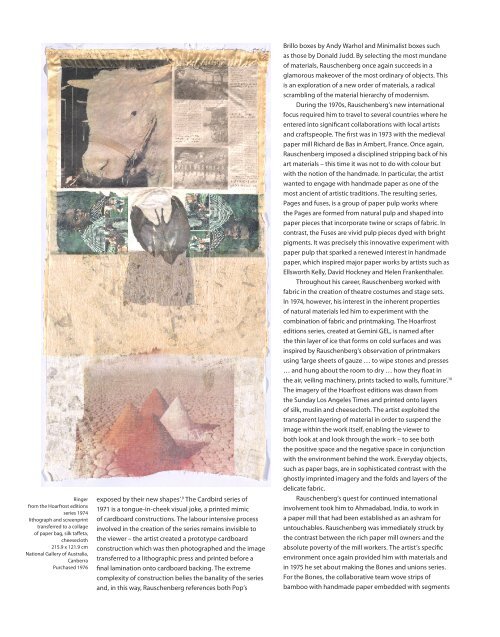Download Room Brochure - National Gallery of Australia
Download Room Brochure - National Gallery of Australia
Download Room Brochure - National Gallery of Australia
You also want an ePaper? Increase the reach of your titles
YUMPU automatically turns print PDFs into web optimized ePapers that Google loves.
Ringer<br />
from the Hoarfrost editions<br />
series 1974<br />
lithograph and screenprint<br />
transferred to a collage<br />
<strong>of</strong> paper bag, silk taffeta,<br />
cheesecloth<br />
215.9 x 121.9 cm<br />
<strong>National</strong> <strong>Gallery</strong> <strong>of</strong> <strong>Australia</strong>,<br />
Canberra<br />
Purchased 1976<br />
exposed by their new shapes’. 9 The Cardbird series <strong>of</strong><br />
1971 is a tongue-in-cheek visual joke, a printed mimic<br />
<strong>of</strong> cardboard constructions. The labour intensive process<br />
involved in the creation <strong>of</strong> the series remains invisible to<br />
the viewer – the artist created a prototype cardboard<br />
construction which was then photographed and the image<br />
transferred to a lithographic press and printed before a<br />
final lamination onto cardboard backing. The extreme<br />
complexity <strong>of</strong> construction belies the banality <strong>of</strong> the series<br />
and, in this way, Rauschenberg references both Pop’s<br />
Brillo boxes by Andy Warhol and Minimalist boxes such<br />
as those by Donald Judd. By selecting the most mundane<br />
<strong>of</strong> materials, Rauschenberg once again succeeds in a<br />
glamorous makeover <strong>of</strong> the most ordinary <strong>of</strong> objects. This<br />
is an exploration <strong>of</strong> a new order <strong>of</strong> materials, a radical<br />
scrambling <strong>of</strong> the material hierarchy <strong>of</strong> modernism.<br />
During the 1970s, Rauschenberg’s new international<br />
focus required him to travel to several countries where he<br />
entered into significant collaborations with local artists<br />
and craftspeople. The first was in 1973 with the medieval<br />
paper mill Richard de Bas in Ambert, France. Once again,<br />
Rauschenberg imposed a disciplined stripping back <strong>of</strong> his<br />
art materials – this time it was not to do with colour but<br />
with the notion <strong>of</strong> the handmade. In particular, the artist<br />
wanted to engage with handmade paper as one <strong>of</strong> the<br />
most ancient <strong>of</strong> artistic traditions. The resulting series,<br />
Pages and fuses, is a group <strong>of</strong> paper pulp works where<br />
the Pages are formed from natural pulp and shaped into<br />
paper pieces that incorporate twine or scraps <strong>of</strong> fabric. In<br />
contrast, the Fuses are vivid pulp pieces dyed with bright<br />
pigments. It was precisely this innovative experiment with<br />
paper pulp that sparked a renewed interest in handmade<br />
paper, which inspired major paper works by artists such as<br />
Ellsworth Kelly, David Hockney and Helen Frankenthaler.<br />
Throughout his career, Rauschenberg worked with<br />
fabric in the creation <strong>of</strong> theatre costumes and stage sets.<br />
In 1974, however, his interest in the inherent properties<br />
<strong>of</strong> natural materials led him to experiment with the<br />
combination <strong>of</strong> fabric and printmaking. The Hoarfrost<br />
editions series, created at Gemini GEL, is named after<br />
the thin layer <strong>of</strong> ice that forms on cold surfaces and was<br />
inspired by Rauschenberg’s observation <strong>of</strong> printmakers<br />
using ‘large sheets <strong>of</strong> gauze … to wipe stones and presses<br />
… and hung about the room to dry … how they float in<br />
the air, veiling machinery, prints tacked to walls, furniture’. 10<br />
The imagery <strong>of</strong> the Hoarfrost editions was drawn from<br />
the Sunday Los Angeles Times and printed onto layers<br />
<strong>of</strong> silk, muslin and cheesecloth. The artist exploited the<br />
transparent layering <strong>of</strong> material in order to suspend the<br />
image within the work itself, enabling the viewer to<br />
both look at and look through the work – to see both<br />
the positive space and the negative space in conjunction<br />
with the environment behind the work. Everyday objects,<br />
such as paper bags, are in sophisticated contrast with the<br />
ghostly imprinted imagery and the folds and layers <strong>of</strong> the<br />
delicate fabric.<br />
Rauschenberg’s quest for continued international<br />
involvement took him to Ahmadabad, India, to work in<br />
a paper mill that had been established as an ashram for<br />
untouchables. Rauschenberg was immediately struck by<br />
the contrast between the rich paper mill owners and the<br />
absolute poverty <strong>of</strong> the mill workers. The artist’s specific<br />
environment once again provided him with materials and<br />
in 1975 he set about making the Bones and unions series.<br />
For the Bones, the collaborative team wove strips <strong>of</strong><br />
bamboo with handmade paper embedded with segments
















